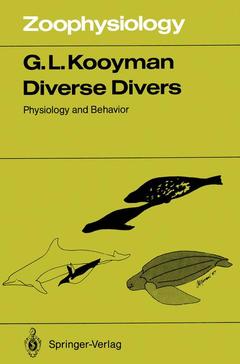Diverse Divers, Softcover reprint of the original 1st ed. 1989 Physiology and behavior Zoophysiology Series, Vol. 23
Langue : Anglais

This book is not a conventional review of diving physiology. The coverage of the literature has been selective rather than en compassing, the emphasis has been on field studies rather than laboratory investigations, and the dive responses described are often discussed from the perspective of some of the flaws or weaknesses in the conclusions. Some of these points are of more historical interest to note how our concepts have evolved as we learn more about behavior and responses to natural diving in contrast to forced submersions in the laboratory. As a result there is a degree of evaluation of some experiments on my part that may seem obvious or controversial to the specialist. I have followed this planat times in order to aid the reader, who I hope is often an untergraduate or graduate stu dent, the nonspecialist, and the layman, in appreciating to some degree the level of dissatisfaction or skepticism about certain areas of research in diving physiology. In view of historical boundaries in vertebrate biology, the subject is of broad enough importance to catch the interest of a wide audience of readers if I have done my job well. For ex ample, of the major epochal transitions or events there have been in vertebrate history, three come immediately to mind: (1) The transition from aquatic to aerial respiration which ultimately led to a broad occupation of terrestrial habitats. (2) The development of endothermy.
1. A Perspective.- 1.1 Forced Submersion and Diving.- 1.2 Content.- 2. Tolerance to Anoxia.- 2.1 Reptiles.- 2.2 Mammals.- 2.3 Conclusions and Summary.- 3. Forced Submersion and Circulation.- 3.1 Historical.- 3.2 Cardiovascular Responses to Forced Submersions.- 3.3 Conclusions and Summary.- 4. Effect of Pressure on the Diving Animal.- 4.1 Nitrogen Narcosis.- 4.2 High Pressure Nervous Syndrome.- 4.3 Oxygen Toxicity.- 4.4 Decompression Sickness.- 4.5 Effect of Pressure on the Diving Animal.- 4.6 Conclusions and Summary.- 5. Oxygen Stores.- 5.1 Pulmonary Storage of Oxygen.- 5.2 Oxygen Storage in Blood.- 5.3 Muscle Oxygen Store.- 5.4 Total Body Oxygen Stores.- 5.5 Hypothesis on the Limits of Durations of Dives.- 5.6 Conclusions and Summary.- 6. Heart Rate.- 6.1 Reptiles.- 6.2 Birds.- 6.3 Mammals.- 6.4 Neurological Control.- 6.5 Conclusions and Summary.- 7. Splanchnic and Renal Blood Flow.- 7.1 Renal Function in Diving.- 7.2 Splanchnic Blood Flow.- 7.3 Conclusions and Summary.- 8. Blood and Muscle Metabolites: Clues to Flow.- 8.1 Muscle Physiology.- 8.2 Reptiles.- 8.3 Birds.- 8.4 Mammals.- 8.5 Conclusions.- 8.6 Summary.- 9. Blood Gases.- 9.1 General Properties.- 9.2 Reptiles.- 9.3 Birds.- 9.4 Mammals.- 9.5 Conclusions and Summary.- 10. Metabolism.- 10.1 Metabolic Rate.- 10.2 Hypometabolism.- 10.3 Fuels.- 10.4 Conclusions and Summary.- 11. Hydrodynamics, Swim Velocity and Power Requirements.- 11.1 Hydrodynamics.- 11.2 Behavior.- 11.3 Power Requirements.- 11.4 Conclusions and Summary.- 12. Aerobic Dive Limit.- 12.1 Definitions.- 12.2 Calculations.- 12.3 Conclusions and Summary.- 13. Behavior.- 13.1 Reptiles.- 13.2 Birds.- 13.3 Mammals.- 13.4 Conclusions and Summary.- 14. Final Remarks.- References.- Name Index.
Date de parution : 12-2011
Ouvrage de 200 p.
17x24.4 cm
Disponible chez l'éditeur (délai d'approvisionnement : 15 jours).
Prix indicatif 105,49 €
Ajouter au panierThèmes de Diverse Divers :
Mots-clés :
adaptation; animals; ecology; mammals; metabolism; muscle; nitrogen; physiology; reptiles
© 2024 LAVOISIER S.A.S.



